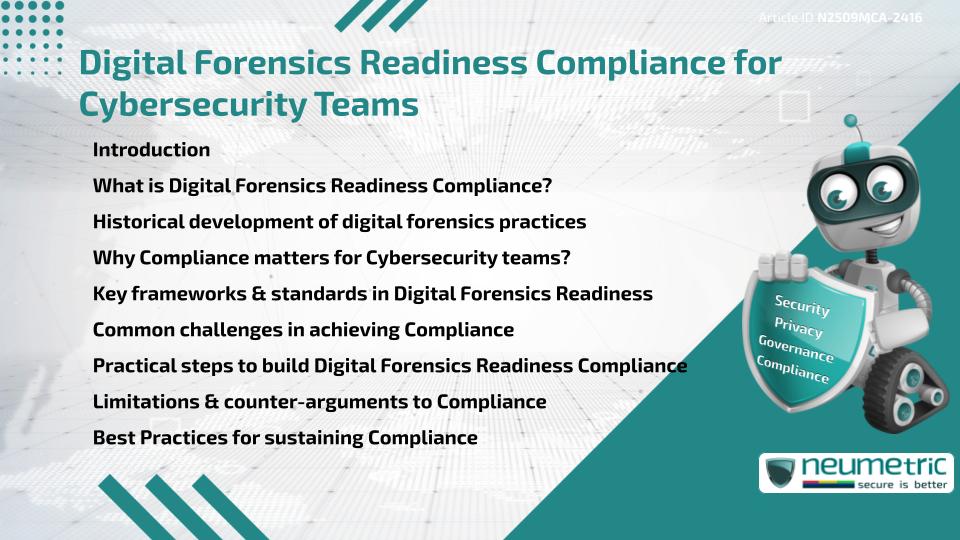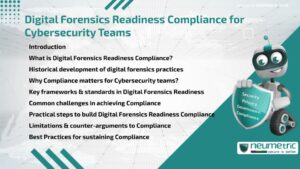Table of Contents
ToggleIntroduction
Digital Forensics Readiness Compliance refers to an organisation’s ability to prepare, collect, preserve & use digital Evidence effectively in the event of a Cyber Incident. For Cybersecurity teams, it ensures that Evidence is legally admissible, accurate & useful in both Investigations & Regulatory reporting. Without readiness, organisations Risk losing Critical Evidence, facing Legal setbacks or failing to meet Industry Standards. This article explains Digital Forensics Readiness Compliance, its historical roots, why it matters, the key standards, challenges & practical steps Cybersecurity teams can follow.
What is Digital Forensics Readiness Compliance?
Digital Forensics Readiness Compliance involves establishing Policies, Processes & Technologies that allow digital Evidence to be identified & preserved systematically before an Incident occurs. It prepares teams to manage investigations efficiently while complying with Legal & Regulatory frameworks.
In simple terms, it is like having a fire extinguisher ready before a fire starts. You may not always use it, but when an incident arises, being prepared ensures a quick, lawful & reliable response.
Historical development of digital forensics practices
Digital forensics emerged in the 1980s with the rise of personal computing & early cybercrime cases. Initially, forensic investigations were reactive, focusing on collecting Evidence after a Breach. However, as Threats grew more complex, Law enforcement & Organisations realised the importance of proactive preparation.
Global Standards such as ISO/IEC 27037 for Evidence Handling & NIST’s guidelines on Forensic Processes highlight this evolution. The shift from reactive investigations to Digital Forensics Readiness Compliance has allowed Cybersecurity teams to minimise delays, preserve Integrity & ensure Legal acceptance of Evidence.
Why Compliance matters for Cybersecurity teams?
Cybersecurity teams benefit from Digital Forensics Readiness Compliance in several ways:
- Legal admissibility: Evidence gathered in Compliance with standards holds weight in court.
- Regulatory requirements: Many industries mandate forensic readiness under Data Protection & Cybersecurity laws.
- Faster Incident Response: Preparedness enables teams to quickly analyse & contain Breaches.
- Cost efficiency: Readiness reduces the expense of Ad-hoc investigations by streamlining processes.
- Reputation protection: Demonstrating Compliance reassures Stakeholders & Customers that Incidents are handled properly.
Without Compliance, organisations Risk Penalties, longer Downtime & damaged Trust.
Key frameworks & standards in Digital Forensics Readiness
Several recognised frameworks guide Cybersecurity teams:
- ISO/IEC 27037: Guidelines for identification, collection, acquisition & preservation of Evidence.
- ISO/IEC 27041: Assurance in Digital Investigations.
- ISO/IEC 27042: Analysis & interpretation of digital Evidence.
- NIST SP 800-86: Integrating forensic techniques into Incident Response.
These standards ensure that Evidence is reliable, Procedures are consistent & Compliance meets both technical & legal expectations.
Common challenges in achieving Compliance
Despite its importance, Digital Forensics Readiness Compliance presents hurdles:
- High technical requirements: Maintaining proper tools & storage facilities for Evidence is costly.
- Skilled workforce shortage: Forensic expertise is specialised & often limited.
- Data volume: The massive amount of logs & digital activity can overwhelm forensic systems.
- Cross-jurisdictional issues: Evidence handling laws vary across countries, complicating multinational investigations.
Compliance requires balancing these obstacles with the necessity of strong Evidence management.
Practical steps to build Digital Forensics Readiness Compliance
Cybersecurity teams can follow structured steps:
- Develop clear Policies for Evidence handling & documentation.
- Train staff in Forensic Readiness, focusing on both technical & legal knowledge.
- Implement Logging & Monitoring systems that preserve activity records securely.
- Regularly Audit readiness to ensure Compliance with Standards.
- Engage legal advisors to align Evidence handling with jurisdictional requirements.
- Test forensic response through simulations & tabletop exercises.
These steps help organisations ensure they are not caught unprepared during an actual incident.
Limitations & counter-arguments to Compliance
Some argue that Digital Forensics Readiness Compliance can be resource-intensive & bureaucratic. Smaller organisations may see it as unnecessary unless they regularly face Cyber Incidents. Additionally, strict adherence to Compliance may slow down investigations if teams focus more on processes than agility.
However, these counter-arguments underestimate the consequences of non-compliance, which can be far more damaging in terms of fines, lawsuits & reputational loss.
Best Practices for sustaining Compliance
To maintain long-term Compliance, organisations should:
- Foster a culture of Accountability for digital Evidence.
- Integrate Forensic Readiness into the broader Cybersecurity strategy.
- Update Systems & Tools regularly to keep pace with emerging Threats.
- Share knowledge with industry peers to stay aligned with evolving practices.
Sustainability comes from embedding Compliance into everyday processes, not treating it as a one-time project.
Conclusion
Digital Forensics Readiness Compliance is a cornerstone for Cybersecurity teams aiming to protect Evidence, meet Legal standards & respond efficiently to incidents. While challenges & limitations exist, its benefits far outweigh the costs. By adopting recognised frameworks, preparing systematically & building a culture of readiness, organisations can safeguard both their operations & their reputation.
Takeaways
- Digital Forensics Readiness Compliance ensures Evidence is reliable, admissible & legally compliant.
- It evolved from reactive forensics to proactive readiness.
- Standards such as ISO/IEC 27037 & NIST SP 800-86 guide forensic Compliance.
- Key challenges include costs, expertise shortages & data volume.
- Sustained Compliance requires cultural & procedural integration.
FAQ
What does Digital Forensics Readiness Compliance mean?
It means preparing systems, Policies & teams to handle digital Evidence lawfully & effectively before an Incident occurs.
Why is Digital Forensics Readiness Compliance important for Cybersecurity teams?
It ensures faster response, Legal admissibility of Evidence, Regulatory Compliance & cost efficiency in handling Incidents.
Which standards govern forensic readiness?
Key standards include ISO/IEC 27037, ISO/IEC 27041, ISO/IEC 27042 & NIST SP 800-86.
What are the main challenges to Compliance?
They include high costs, limited expertise, overwhelming data volumes & differing legal requirements across countries.
Can small organisations achieve Digital Forensics Readiness Compliance?
Yes, by prioritising essential Policies, using external expertise & adopting scalable tools, even smaller organisations can comply effectively.
Does Compliance guarantee security?
No, Compliance ensures preparedness but must be paired with strong Cybersecurity practices for overall protection.
How can organisations sustain Compliance?
By embedding forensic readiness into everyday processes, updating tools & ensuring continuous staff training.
Need help for Security, Privacy, Governance & VAPT?
Neumetric provides organisations the necessary help to achieve their Cybersecurity, Compliance, Governance, Privacy, Certifications & Pentesting needs.
Organisations & Businesses, specifically those which provide SaaS & AI Solutions in the Fintech, BFSI & other regulated sectors, usually need a Cybersecurity Partner for meeting & maintaining the ongoing Security & Privacy needs & requirements of their Enterprise Clients & Privacy conscious Customers.
SOC 2, ISO 27001, ISO 42001, NIST, HIPAA, HECVAT, EU GDPR are some of the Frameworks that are served by Fusion – a SaaS, multimodular, multitenant, centralised, automated, Cybersecurity & Compliance Management system.
Neumetric also provides Expert Services for technical security which covers VAPT for Web Applications, APIs, iOS & Android Mobile Apps, Security Testing for AWS & other Cloud Environments & Cloud Infrastructure & other similar scopes.
Reach out to us by Email or filling out the Contact Form…





